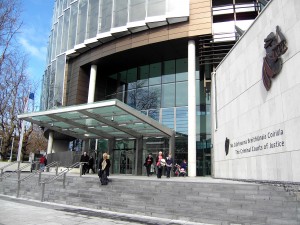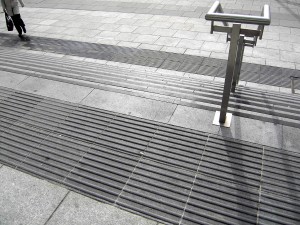2011-04-07: The United Nations Convention on the Rights of Persons with Disabilities (CRPD) is an issue, right here and now, for Architects in Ireland … and the Irish Built Environment, whoever designs, constructs, operates or manages it … not because this country has, or has not, ratified the Convention … but because the European Union has ratified this Convention ! And as we have all witnessed, on countless times since the early 1970’s … it has required a big stick from Europe to drag Ireland’s social legislation into the modern era.
UN CRPD Article 13 – Access to Justice
1. States Parties shall ensure effective access to justice for persons with disabilities on an equal basis with others, including through the provision of procedural and age-appropriate accommodations, in order to facilitate their effective role as direct and indirect participants, including as witnesses, in all legal proceedings, including at investigative and other preliminary stages.
2. In order to help to ensure effective access to justice for persons with disabilities, States Parties shall promote appropriate training for those working in the field of administration of justice, including police and prison staff.
Last week … from Monday, 28 March 2011 … until Thursday, 31 March 2011 … I attended as a Juror at the New Criminal Courts of Justice Building, which is located at the Main Gate to the Phoenix Park in Dublin … near the junction between Parkgate Street and Infirmary Road.
I was very curious to experience this new building as an ordinary user. However, I was not at all happy at the outcome … the accessibility performance was so inadequate.
In the case of this new building, it is clear that the Irish State has failed – is failing – to comply with Article 13 of the UN Convention on the Rights of Persons with Disabilities … and is thus denying a basic human right to many people in our society.

.
Post Occupation Evaluation (POE) is not a well-known architectural concept among architects … and even when it is known, it is not the most favoured. This subject has, in my direct experience, been treated with light-hearted frivolity in 8 Merrion Square, Dublin ! Afterall, who wants to meet the failures of their cherished designs head-on … up-front and in their faces ?? To some architects, successes never seem to count as being of equal, or more, importance. But, they are both a vital tool in continuous learning.
POE, however, is a crucial part of work as a practicing architect. It is essential to feed previous design failures and successes … and ‘real’ information about building user/occupant behaviour … back into new projects ! This is ‘real’ CPD (Continuing Professional Development) in action … and a serious issue which is completely overlooked in the Royal Institute of the Architects of Ireland’s current approach to CPD !!
The reason so much of the built environment … so many buildings … is/are so inaccessible for many people … is not because designers have something against people with activity limitations … it is because designers just do not want human beings … anybody … to enter and use their buildings. People are so messy … and they always want to do silly things with a building which were never planned … or they want to change things around, spoiling ‘the design’ … etc., etc., etc.
This problem begins back in the architectural schools, and becomes a deeper problem on the professional practice courses organized by professional institutes … here, and in other countries. POE and building user/occupant behaviour is not covered … at all ! Can you believe that ?? I still can’t.
Tyranny of the Plan is another architectural concept. I will try to explain it this way. Take the photograph above. Why, for example, are there no handrails on the right hand side … the major part … of those steps ? Because of that Tyranny of the Plan Drawing ! It looked ‘right’ … beautiful, almost sexy … just to have handrails on that part of the steps leading from the main front doors … design movement was continued and controlled. This is not the same as people movement.
On Sunday morning last, I measured those steps myself … (riser) 150 mm in height x (going) 300 mm in depth … (2 x riser) + (1 x going) = 600 mm … ideal dimensions for steps inside a building … but not the most convenient, comfortable or safe dimensions for steps outside a building.
Handrails are definitely required throughout the full extent of the steps ! But, that would have looked very sloppy on the plan drawing. Now, however, take a closer look at those steps … looking down from above … and just imagine that you are a frail, older person and your sight may not be the greatest … that you are visually impaired in some manner …

The wrong type of tactile ground surface information is being given at the top and bottom of the steps … we would like to warn users of the hazard they are approaching, i.e. the steps, by using a ‘blister’ surface indicator … not direct them to turn left or right when they perceive those continuous ‘corduroy’ ridges. The horizontal handrail extensions at the top and bottom of the short flight of steps are insufficiently long. There is inadequate visual contrast at all of the step nosings (i.e. the leading top edges) which would have helped people to accurately locate those edges. And, as already referred to above, the step dimensions could have been greatly improved with a slight adjustment … for example, (riser) 125 mm in height x (going) 350 mm in depth … (2 x riser) + (1 x going) = 600 mm … much better altogether for steps outside a building ! Compare and contrast with the many Japanese photographs shown in earlier posts. There is no comparison ! This is sloppy work in Dublin.
Mies van der Rohe (1886-1969), the Master German Architect, is often quoted as having said: “God is in the details”. Right on, Ludwig … ride ’em cowboy !!!
.
For security reasons, it was not possible to take any photographs inside the building. However, it was abundantly clear that accessibility for people with activity limitations, generally, was inadequate. While some small account had been taken of the needs of people using wheelchairs … people with a visual impairment would have a very difficult time using this building. Furthermore, when it came to the ‘swearing-in’ of Jurors at Court No.7, circulation was incredibly confined and restricted … I was having to squeeze myself forward in order to be ‘processed’. What a mess !
This was an unacceptable and very disappointing example of poor, misguided and minimalist accessibility implementation … making an ironclad case for effective independent verification of Accessibility Performance, as required by the United Nations Convention on the Rights of Persons with Disabilities … at the end of the design stage in a project, and especially during the actual process of construction … to ensure that an ‘informed’ design intention becomes reality.
UN CRPD Article 33 – National Implementation & Monitoring
1. States Parties, in accordance with their system of organization, shall designate one or more focal points within government for matters relating to the implementation of the present Convention, and shall give due consideration to the establishment or designation of a co-ordination mechanism within government to facilitate related action in different sectors and at different levels.
2. States Parties shall, in accordance with their legal and administrative systems, maintain, strengthen, designate or establish within the State Party, a framework, including one or more independent mechanisms, as appropriate, to promote, protect and monitor implementation of the present Convention. When designating or establishing such a mechanism, States Parties shall take into account the principles relating to the status and functioning of national institutions for protection and promotion of human rights.
3. Civil society, in particular persons with disabilities and their representative organizations, shall be involved and participate fully in the monitoring process.
.
And that is not the end of the story ! When construction of a building has been completed and it is then occupied, Competent Building Management is critical in maintaining an initial level of good accessibility performance throughout the life cycle of that building. Once again, however, the management of this building was sloppy … take a bow, the Courts Service of Ireland !
Symptoms of Larger Problems … Two Short Little Anecdotes …
a) Unheeded Building Evacuation Warning
In the middle of Roll Call, on the first morning that I attended as a Juror, a Voiced Stand-By Building Evacuation Warning was announced over the building’s public address system. It was explained that there had been ‘an incident’. That’s all … no other information was given. This announcement was repeated again, and again, and again. It then stopped, momentarily, and then started again. It finally ended.
During the announcements … we all looked around … there were at least 150 people in the room … then looked at each other, shrugged our shoulders and smiled. We at least thought that the person in charge of the Roll Call would be in a position to quickly find out what was going on … but no, she also shrugged her shoulders and carried on calling out names.
Afterwards, I asked one of the many ushers what had happened … was it a serious incident ? He didn’t know, and just stated that ushers are generally told nothing.
This is entirely unacceptable ! Are clowns managing the New Criminal Courts of Justice Building in Dublin ??
b) Disrespectful ‘Swearing-In’ of Jurors
An Information Leaflet, produced by the Courts Service back in January 2010, entitled: ‘Attending for Jury Service’ … contains the following Introduction …
Jury Service is an important civic duty. It is a vital part of our criminal justice system. You must arrive on time to ensure trials are not delayed. To assist you we have prepared this leaflet which includes a map to guide you to (the) jury assembly area of the Criminal Courts of Justice.
Concerning ‘Swearing-In a Jury’ … it is stated in the Leaflet …
The court registrar calls out your name and asks you to take an oath on the Holy Book of your choice, or you may affirm.
From the beginning, nobody was informed about these options. On the final morning, when I was selected to be a Juror, the only Holy Book which was placed in front of Jurors was the Christian Bible. No other Holy Book was visible. Everyone was being processed in one way … without any consideration or respect for their dignity as an individual person.
With all of the stress of these occasions, and the formalities involved … the ‘Swearing-In’ Judge was even wearing a wig (I thought that those days were long gone !) … it would be all too easy for people … ‘automatically’, almost by reflex action, and not wanting to make a fuss … to go through a ‘standard’ processing procedure, which for them had little or no meaning. Is that the intended purpose of ‘Swearing-In’ ??
It may have escaped the attention of the Courts Service that Ireland is now a pluralist and richly varied multi-cultural society. Some people are religious, others are not … some people are Christians, others are Moslems, Jews or Buddhists, etc., etc … whatever !
A range of Holy Books must be visible to all Jurors … and they must all be informed about the option of ‘Affirming’ … before ‘Swearing-In’ commences !
.
.
END
